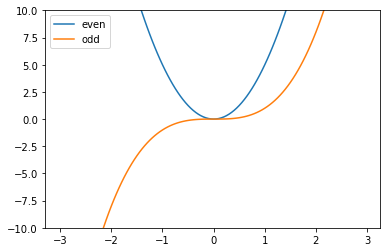Function Palooza#
In physics, there are a handful of functions that you should know by heart. I’ve outlined them (and their derivatives) here.
Constants and Polynomials#
Function |
Derivative |
|---|---|
\(a\) |
\(0\) |
\(x^a\) |
\(ax^{a-1}\) |
Example#
By linearity of the derivative and the power rule.
Real Valued Exponential#
Function |
Derivative |
|---|---|
\(e^x\) |
\(e^x\) |
The exponential, denoted \(e^x\) or \(\exp{(x)}\) is probably the most important function in physics (I would argue in math in general as well). This is because it has the incredible property of being its own derivative.
Example#
By the chain rule. You should become very comfortable with this kind of derivative.
Complex Valued Exponential#
Perhaps this isn’t the best time to introduce this, but its too important for me to leave out:
This is called Euler’s Formula* .
More generally: $\( e^{x+iy} = e^x(\cos(y) + i\sin(y)) \)$
Natural Log#
Function |
Derivative |
|---|---|
\(\ln{(x)}\) |
\(\frac{1}{x}\) |
The natural log is the inverse of the exponential, that is \(\ln{(e^x)} = x\) and \(e^{\ln{(x)}} = x\). \(\ln{(...)}\) is often denoted by just \(\log{(...)}\). Also, it is good to know that \(\ln{(1)} = 0\).
Properties (log rules)#
Log properties |
|
|---|---|
Powers |
\(\ln{(x^a)} = a\ln{(x)}\) |
Products |
\(\ln{(xy)} = \ln{(x)} + \ln{(y)}\) |
Division |
\(\ln{\left(\frac{x}{y}\right)} = \ln{(x)} - \ln{(y)}\) |
Exponentials of a different base#
Now that we know \(e^x\) and \(\ln{(x)}\), we can define exponentials of any base:
Trig Functions#
Function |
Derivative |
|---|---|
\(\sin(x)\) |
\(\cos(x)\) |
\(\cos(x)\) |
\(-\sin(x)\) |
\(\tan(x)\) |
\(\frac{1}{\cos^2(x)}\) |
Recall that \(\tan(x) := \frac{\sin(x)}{\cos(x)}\).
The most important trig identity is: \(\sin^2 (x) + \cos^2(x) = 1\). I won’t write other ones down since they are easy to look up.
\(\sin(x)\) and \(\cos(x)\) are \(2\pi\) periodic, so they repeat every \(2\pi\). The function \(\sin(\omega x)\) then is \(\frac{2\pi}{\omega}\) periodic.
Exponential Form#
Function |
Exp. Form |
|---|---|
\(\cos(\theta)\) |
\(\frac{e^{i\theta} + e^{-i\theta}}{2}\) |
\(\sin(\theta)\) |
\(\frac{e^{i\theta} - e^{-i\theta}}{2i}\) |
Inverse Trig functions#
Here I favor the “arc” notation instead of \(^{-1}\) notation, since the latter can be confusing.
Function |
Derivative |
|---|---|
\(\arctan(x)\) |
\(\frac{1}{1+x^2}\) |
\(\arcsin(x)\) |
\(\frac{1}{\sqrt{1-x^2}}\) |
\(\arccos(x)\) |
\(-\frac{1}{\sqrt{1-x^2}}\) |
\(\arctan\) is probably the only one worth commiting to memory here. \(\arctan\) is technically a multi valued function, but almost always, you can assume that \(\arctan(x)\) will spit out a value in \((\pi/2,\pi/2)\).
Hyperbolic Trig Functions#
These are less common, but still good to know as they do come up from time to time in physics.
Function |
Derivative |
|---|---|
\(\sinh(x)\) |
\(\cosh(x)\) |
\(\cosh(x)\) |
\(\sinh(x)\) |
\(\tanh(x)\) |
\(\frac{1}{\cosh^2(x)}\) |
Exponential Form#
Function |
Exp. Form |
|---|---|
\(\cosh(x)\) |
\(\frac{e^x + e^{-x}}{2}\) |
\(\sinh(x)\) |
\(\frac{e^x - e^{-x}}{2}\) |
\(\tanh(x)\) |
\(\frac{e^x - e^{-x}}{e^x + e^{-x}}\) |
Even and odd functions#
Many, but not all functions can be classified as even or odd. I’ll define these properties now:
Def.
\(f\) is even if \(f(-x) = f(x)\)
\(f\) is odd if \(f(-x) = -f(x)\)
Here is a classic example of even and odd functions:
import numpy as np
import matplotlib.pyplot as plt
x = np.arange(-3,3,0.05);plt.plot(x,5*x**2, label = 'even');plt.plot(x,x**3, label = 'odd')
plt.ylim(-10,10);plt.legend();plt.show()

Even or odd?#
Function |
even or odd |
|---|---|
\(\sin(x)\) |
odd |
\(\cos(x)\) |
even |
\(x^n, n\) even |
even |
\(x^n, n\) odd |
odd |
\(\cosh(x)\) |
even |
\(\sinh(x)\) |
odd |
\(\tanh(x)\) |
odd |
\(\arctan(x)\) |
odd** |
